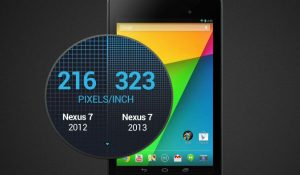New Nexus 7 2 vs Nexus 7

The 2013 new Nexus 7 is here. The Nexus 7 2, as it has been called by some, has a faster processer, better screen and – in one model at least – 4G connectivity.
Read the full Nexus 7 2 review
Is it worth upgrading for existing Nexus 7 owners? Is it worth grabbing a bargain and getting the older version or splashing the cash and going for the 2013 model?
We help you make the right decision by comparing the two.
Bored of reading? Watch the video comparison:
New Nexus 7 (2013) vs Nexus 7 – Design
New Nexus 7 – 8mm thick, around 300g
Nexus 7 – 10mm thick, 340g
The basic shape of the Nexus 7 has not changed. The new Nexus 7 still has the same aspect, and the same style of design when viewed front-on.
Asus has managed to cut down the bezel a little, most noticeably to the left and right of the display – above and below there remains a chunky expanse of screen surround. In fact the new Nexus 7 is a little taller than its predecessor. Google says there’s 3mm less blank space on each side, letting the tablet become 6mm less wide.
It’s also a lighter and thinner tablet – 50g lighter and just 7.9mm thick.
New Nexus 7 (2013) vs Nexus 7 – Screen
New Nexus 7 – 7-inch 1,920 x 1,080 pixels IPS
Nexus 7 – 7-inch 1,280 x 800 pixels IPS
Perhaps the most important improvement made in the second-generation Nexus 7 is the new screen. Although the screen size and aspect have remained entirely the same, the resolution has been upped massively.
Where the first-gen tablet had a 1,280 x 800 pixel IPS screen, the Nexus 7 2 has been boosted to full 1080p (1920 x 1200 to be exact). Pixel density in the second-gen Nexus is 323 ppi, which is huge for a tablet.

As a more advanced panel, other image quality elements such as colour rendition and contrast have also improved. The original Nexus 7’s display wasn’t hugely impressive.
New Nexus 7 (2013) vs Nexus 7 – Software
New Nexus 7 – Android 4.3
Nexus 7 – launched with Android 4.1, Android 4.3 update available
The Google Nexus devices are used to show off the very latest versions of the Android OS. The first Nexus 7 was the guinea pig for Android 4.1, back when it launched in mid-2012.
For the second-gen model, we’re looking at Android 4.3 for the very first time.
New features include Bluetooth Smart support, a new kid-friendly zone with your tablet/phone, improved Google Maps and OpenGL ES 3.0 support for better graphical potential in games.
It’s not an earth-shattering change, and the original Nexus 7 will get Android 4.3 anyway. When it comes to Nexus devices, year-to-year upgrades are more about hardware than software, as older devices will generally get an upgrade to the newest software. 
New Nexus 7 (2013) vs Nexus 7 – CPU, RAM
New Nexus 7 – 1.5GHz Snapdragon S4 Pro quad-core, 2GB RAM
Nexus 7 – Tegra 3 quad-core, 1GB RAM
The first Nexus 7 used a Tegra 3 processor by NVIDIA, generally considered a pretty good mobile processor, and one that has a particularly nifty GPU. Or at least that’s what we thought when it arrived.
Times have moved on, but the second Nexus 7 does not use a Tegra-series chip. Instead, it has a Qualcomm Snapdragon S4 Pro processor, similar to the one seen in the Sony Xperia Z.
It’s a quad-core chipset clocked at 1.5GHz.
This is a healthy upgrade, and RAM has been doubled in the second-generation model – from 1GB to 2GB.
New Nexus 7 (2013) vs Nexus 7 – Camera
New Nexus 7 – 5-megapixel main camera, 1.2-megapixel front camera
Nexus 7 – 1.2-megapixel front camera
The first Nexus 7 was one of the key tablets that chose not to incorporate a rear camera. We applauded it as a classy move that stopped less discerning tablet users from looking foolish trying to take snaps with their tablet.
Google’s second 7-inch tablet has taken more of an “everything but the kitchen sink” approach. It has two cameras, a 5-megapixel sensor on the back and a 1.2-megapixel one for selfies and video chat.
There’s no flash on the rear camera, though, so its flexibility is pretty limited. And image quality is pretty poor, even for a tablet camera.

New Nexus 7 (2013) vs Nexus 7 – Internal Speaker
New Nexus 7 – stereo speaker, surround DSP
Nexus 7 – mono speaker
A little-discussed weakness of the generally-great Nexus 7 was its weak internal speaker. It didn’t go very loud, and sounded weedy.
Google and Asus have beefed-up the speaker array in the new Nexus 7. There are now two sets of speakers, positioned to give stereo sound when the tablet is held in landscape orientation.
Google has also packed-in virtual surround sound DSP from Fraunhofer, which is designed to give a surround-like experience with headphones or stereo speakers. It’s not magic, though – it’s the improved speakers and speaker positioning that’s worth shouting about here.
Read our full Nexus 7 review
New Nexus 7 (2013) vs Nexus 7 – Battery Life
New Nexus 7 – 8 hours video
Nexus 7 – 9 hours video
The new Nexus 7 is lighter, thinner and much more pixel-packed than the first-generation model, but this comes at a bit of a price as it has less battery stamina than its predecessor.
Where the Nexus 7 could last for 9 hours at a push when playing video, the second model only manages to squeeze out 8 – and that’s with the brightness set to low.
For more details read the Nexus 7 2 Battery life section of the review.
Early Verdict
The second Nexus 7 is almost identical to the first in its approach. It looks pretty similar, doesn’t have expandable memory, has stayed low-cost and will even run the same software as a fully-updated first-gen model.
What are the most important upgrades? To our minds, there are two. Going from a mid-grade 1,280 x 800 pixel screen to a more up-to-date 1080p one is a huge improvement, and upping the quality of the internal speaker was a great idea. It’s a solid, if not 100 per cent essential, upgrade.
Next read how it compares to Apple’s little bundle of joy: iPad mini vs Nexus 7 2



